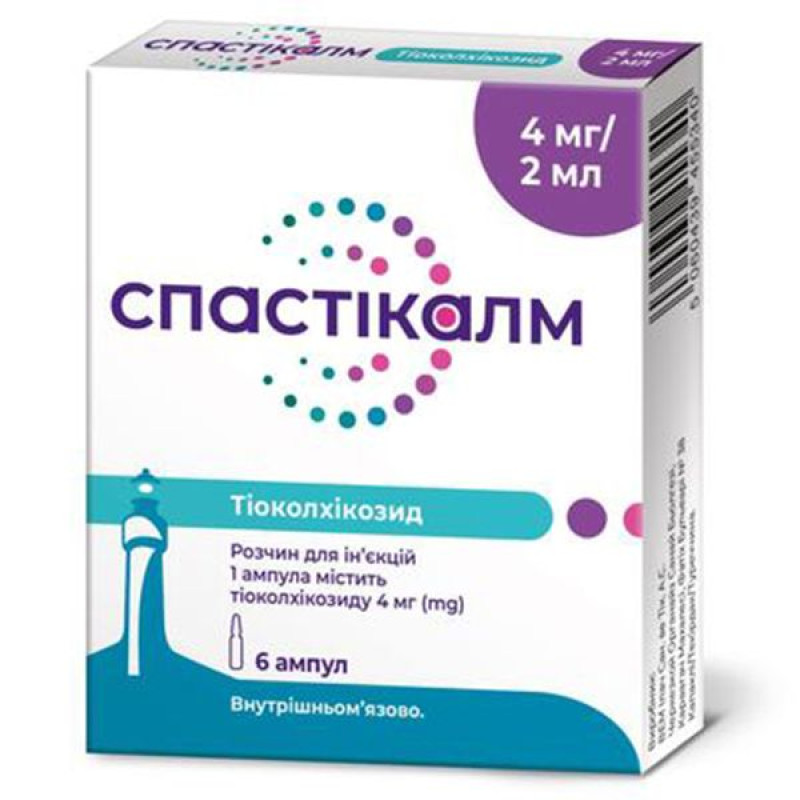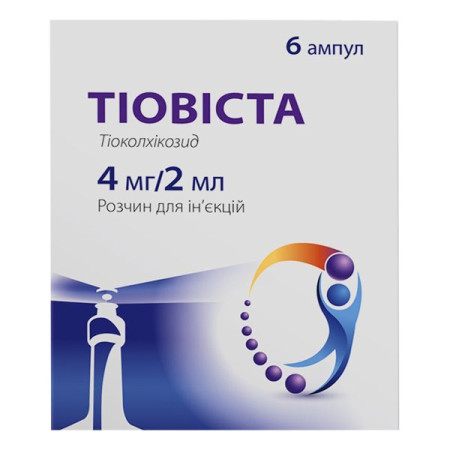Spasticalm solution for injection 4 mg/2 ml ampoule 2 ml No. 6

Instructions for Spasticalm injection solution 4 mg/2 ml ampoule 2 ml No. 6
Composition
active ingredient: thiocolchicoside;
1 ampoule contains thiocolchicoside 4 mg;
Excipients: sodium chloride, hydrochloric acid, sodium hydroxide, water for injections.
Dosage form
Solution for injection.
Main physicochemical properties: clear solution, yellow in color.
Pharmacotherapeutic group
Muscle relaxants with a central mechanism of action. ATC code M0ZV X05.
Pharmacological properties
Pharmacodynamics.
Thiocolchicoside is a semisynthetic sulfide derivative of colchicoside that has a muscle relaxant effect.
In in vitro studies, thiocolchicoside binds only to GABA and strychnine-sensitive glycine receptors. Thiocolchicoside, acting as a GABA receptor antagonist, exerts an effective muscle relaxant effect through regulatory complex mechanisms at the supraspinal level, but its glycinergic mechanism of action cannot be excluded.
The interaction characteristics of thiocolchicoside with GABA receptors are the same as those of its glucuronide derivative, which is the main metabolite (see below).
In in vivo studies, the muscle relaxant properties of thiocolchicoside and its main metabolite have been demonstrated in various experimental models.
Electroencephalographic studies also showed that thiocolchicoside and its main metabolite do not cause a sedative effect.
Pharmacokinetics.
Absorption.
After intramuscular administration, the maximum plasma concentration (Cmax) of thiocolchicoside is observed after 30 minutes, with values of 113 ng/ml being reached after a 4 mg dose and 175 ng/ml after an 8 mg dose. The corresponding area under the pharmacokinetic concentration-time curve (AUC) are 283 ng∙g/ml and 417 ng∙g/ml.
The pharmacologically active metabolite SL18.0740 is also observed at lower concentrations, with a Cmax of 11.7 ng/mL, which is reached 5 hours after dosing, and an AUC of 83 ng∙g/mL. Data on the inactive metabolite SL59.0955 are not available.
Distribution.
The apparent volume of distribution of thiocolchicoside is approximately 42.7 L after intramuscular administration of 8 mg. Data are not available for either metabolite.
Breeding.
The half-life of thiocolchicoside is 1.5 hours, and the plasma clearance is 19.2 l/h.
Indication
Adjunctive therapy for painful muscle contractures in cases of acute spinal pathologies in adults and adolescents aged 16 years and older.
Contraindication
Thiocolchicoside should not be used:
- patients with hypersensitivity to the active substance or to any of the excipients of the medicinal product;
- patients suffering from flaccid paralysis, muscular hypotension;
- throughout the entire period of pregnancy;
- during breastfeeding;
- women of reproductive age who do not use adequate contraception during treatment with Spasticalm and for one month after stopping treatment;
- men who do not use adequate contraception during treatment with Spasticalm and for three months after stopping treatment.
Interaction with other medicinal products and other types of interactions
There is no information on interaction.
Application features
Vasovagal syncope has been reported following intramuscular injection of thiocolchicoside, therefore the patient should be monitored after administration of the medicinal product (see section 4.8).
In the post-marketing period, cases of liver injury have been reported in association with the use of thiocolchicoside. Severe cases (e.g. fulminant hepatitis) of liver injury have been reported in patients receiving concomitant non-steroidal anti-inflammatory drugs (NSAIDs) or paracetamol. If signs of liver injury develop during use of the medicinal product, treatment should be discontinued and a doctor should be consulted (see section "Adverse reactions").
During the use of thiocolchicoside, epileptic seizures may develop in patients suffering from epilepsy or diseases accompanied by a risk of seizures (see section "Adverse reactions").
Do not exceed the maximum recommended dose of thiocolchicoside of 8 mg per day, which should be divided into 2 doses with an interval of 12 hours. If a dose is missed, the next dose should be administered at the usual time.
According to preclinical studies, one of the metabolites of thiocolchicoside, SL59.0955, causes aneuploidy (changes in the number of chromosomes in dividing cells) at concentrations close to 8 mg twice daily when administered orally, which had similar effects in humans.
Aneuploidy is considered a risk factor for teratogenicity, embryo/fetal toxicity, miscarriage, altered male fertility and a potential risk factor for cancer. For prevention, exceeding the recommended dose of the drug or prolonged use should be avoided (see section "Dosage and Administration"). Patients should be well informed about the potential risks to a possible pregnancy and about the effective contraceptive measures that should be used.
Injection site reactions, including injection site necrosis and drug embolism of the skin, also known as Nicolau's syndrome and livedoid dermatitis, have been reported following intramuscular administration of thiocolchicoside (see section 4.8). Proper injection technique must be followed when administering thiocolchicoside intramuscularly.
Important information about excipients.
This medicinal product contains less than 1 mmol (23 mg) sodium/dose, i.e. essentially sodium-free.
Use during pregnancy or breastfeeding
Contraception in women and men
Thiocolchicoside is contraindicated in women of childbearing potential and in men not using effective contraception (see Contraindications).
Due to the aneugenic potential of thiocolchicoside and its metabolites, women of childbearing potential should use effective contraception during treatment with thiocolchicoside and for one month after completion of treatment.
Men should use effective contraception during treatment with thiocolchicoside and for three months after completion of treatment (see section "Contraindications").
Pregnancy.
Information on the use of thiocolchicoside in pregnant women is limited, therefore the potential risk to the embryo and fetus is unknown. Animal studies have shown teratogenic effects of thiocolchicoside. The drug is contraindicated for use during pregnancy (see section "Contraindications").
Breastfeeding period.
Thiocolchicoside passes into breast milk. The drug is contraindicated for use during breastfeeding (see section "Contraindications").
Fertility.
Thiocolchicoside and its metabolites exert aneugenic effects at various concentration levels, which is a risk factor for human fertility.
Ability to influence reaction speed when driving vehicles or other mechanisms
Studies of the effect of thiocolchicoside on the ability to drive vehicles or other mechanisms have not been conducted.
During the use of thiocolchicoside, drowsiness may develop, which should be taken into account when driving or operating other mechanisms.
Method of administration and doses
The drug is intended for intramuscular administration.
The recommended maximum daily dose is 4 mg every 12 hours (8 mg per day). Treatment should not exceed 5 consecutive days.
Exceeding the recommended dose or duration of use should be avoided (see section "Special precautions for use").
Children.
The drug is contraindicated for use in children under 16 years of age.
Overdose
Symptoms: There are no data on cases of overdose.
Treatment: In case of overdose, careful medical supervision of the patient and symptomatic therapy are recommended.
Side effects
The following adverse reactions are listed by MedDRA system organ class and frequency: very common (≥ 1/10), common (≥ 1/100 - < 1/10), uncommon (≥ 1/1,000 - < 1/100), rare (≥ 1/10,000 - < 1/1,000), very rare (< 1/10,000), frequency unknown (cannot be estimated from the available data).
On the part of the immune system:
infrequently - itching; rarely - urticaria; very rarely - arterial hypotension; frequency unknown - angioedema and anaphylactic reactions, including anaphylactic shock.
From the nervous system:
Common: drowsiness; rare: agitation or short-term confusion; frequency unknown: malaise, with or without vasovagal syncope, within the first few minutes after intramuscular injection; convulsions (see section "Special warnings and precautions for use").
From the gastrointestinal tract:
often - diarrhea, stomach pain; infrequently - nausea, vomiting; rarely - heartburn.
From the liver and biliary tract:
frequency unknown – liver damage (see section "Special warnings and precautions for use").
Skin and subcutaneous tissue disorders:
infrequently - allergic skin reactions.
Common pathologies and conditions associated with the injection site:
frequency unknown: injection site reactions including swelling, erythema, pruritus, pain around the injection site and Nicolau syndrome ("drug cutaneous embolism" and "livedoid dermatitis") following intramuscular injection.
Reporting of suspected adverse reactions
Reporting adverse reactions after the registration of a medicinal product is important. This allows monitoring of the benefit/risk ratio of the medicinal product. Medical and pharmaceutical professionals, as well as patients or their legal representatives, should report all cases of suspected adverse reactions and lack of efficacy of the medicinal product via the Automated Information System for Pharmacovigilance at the following link: https://aisf.dec.gov.ua
Expiration date
4 years.
Storage conditions
Store in original packaging at a temperature not exceeding 25 ° C. Keep out of the reach of children.
Packaging
2 ml in an ampoule; 6 ampoules in a cardboard box.
Vacation category
According to the recipe.
Producer
Location of the manufacturer and address of its place of business.
Çerkezkoy Organiz Sanayi Bölgezi, Karaagac Mahallesi, Fatih Boulevard No. 38 Kapakli/ Tekirdak /Turkey.
There are no reviews for this product.
There are no reviews for this product, be the first to leave your review.
No questions about this product, be the first and ask your question.







